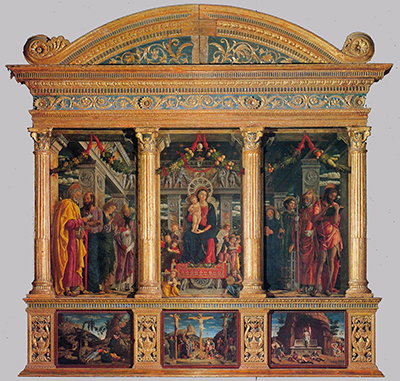Today, the San Zeno Altarpiece is a mix of original and copied artwork, due to the predellas being stripped off the piece in 1797.
The original predellas are now in the Louvre and Musée des Beaux-Arts. The altarpiece itself resides in its home of the Basilica di San Zeno, in Verona. The altarpiece was originally commissioned by the abbot Gregorio Correr, an ecclesiastic who was eventually elected Patriarch of Venice. The wooden frame divides the main scene into three sections using four Corinthian columns. The 1300s Trecento tradition was to have separate images within each frame. However, Mantegna breaks from this tradition by having a continuous image that runs behind the pillars.
The wooden pillars become part of the picture, and the sides and embellishments of the pillars are painted in, giving an incredible illusion of perspective and depth. The figures appear to occupy a space that, with the combined use of painted perspective and wooden sculpture, appears to impinge upon our own reality, as if you could actually step into the painting. Central to the painting is Mary holding Christ on her lap. This is the court of heaven, held in a classical and antique space. Mantegna was heavily influenced by Greek and Roman antiquities, and this was evident in the posing of some of his figures, particularly John the Baptist on the far right.
This type of painting is called a 'sacra conversazione', a holy conversation. In the San Zeno Altarpiece we see St Peter with his keys on the far left, then behind him St Paul, then St John. At the back of them all, eyes fixed on the Virgin Mary, is St Zeno himself. St Zeno is thought to be the Saint that brought Christianity to Verona, and is now the Patron Saint of the town. The overall painting is known for superb naturalism particularly in the posing of the figures and the vivid colour and light created by Mantegna's use of oil paint. Mantegna tried to mimic the way the light entered the church, further exaggerating the realism within the artwork. All of this illusionism was to create the impression of realistic figures that churchgoers can engage with, characters they truly believe will intercede on behalf of them with God.




